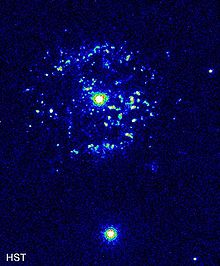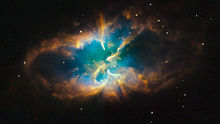Pyxis
| Constellation | |
65th) | |
| Main stars | 3 |
|---|---|
| Bayer/Flamsteed stars | 10 |
| Stars with planets | 3 |
| Stars brighter than 3.00m | 0 |
| Stars within 10.00 pc (32.62 ly) | 1 |
| Brightest star | α Pyx (3.68m) |
| Messier objects | 0 |
| Bordering constellations | Hydra Puppis Vela Antlia |
| Visible at latitudes between +50° and −90°. Best visible at 21:00 (9 p.m.) during the month of March. | |
Pyxis
The plane of the Milky Way passes through Pyxis. A faint constellation, its three brightest stars—Alpha, Beta and Gamma Pyxidis—are in a rough line. At magnitude 3.68, Alpha is the constellation's brightest star. It is a blue-white star approximately 880 light-years (270 parsecs) distant and around 22,000 times as luminous as the Sun.
Pyxis is located close to the stars that formed the old constellation Argo Navis, the ship of Jason and the Argonauts. Parts of Argo Navis were the Carina (the keel or hull), the Puppis (the stern), and the Vela (the sails). These eventually became their own constellations. In the 19th century, John Herschel suggested renaming Pyxis to Malus (meaning the mast) but the suggestion was not followed.
History

In ancient Chinese astronomy, Alpha, Beta, and Gamma Pyxidis formed part of Tianmiao, a celestial temple honouring the ancestors of the emperor, along with stars from neighbouring Antlia.[4]
The French astronomer
German astronomer Johann Bode defined the constellation Lochium Funis, the Log and Line—a nautical device once used for measuring speed and distance travelled at sea—around Pyxis in his 1801 star atlas, but the depiction did not survive.[9] In 1844 John Herschel attempted to resurrect the classical configuration of Argo Navis by renaming it Malus the Mast, a suggestion followed by Francis Baily, but Benjamin Gould restored Lacaille's nomenclature.[7]
Characteristics

Covering 220.8 square degrees and hence 0.535% of the sky, Pyxis ranks 65th of the
Features
Stars

Lacaille gave Bayer designations to ten stars now named Alpha to Lambda Pyxidis, skipping the Greek letters iota and kappa. Although a nautical element, the constellation was not an integral part of the old Argo Navis and hence did not share in the original Bayer designations of that constellation, which were split between Carina, Vela and Puppis.[7] Pyxis is a faint constellation, its three brightest stars—Alpha, Beta and Gamma Pyxidis—forming a rough line.[14] Overall, there are 41 stars within the constellation's borders with apparent magnitudes brighter than or equal to 6.5.[d][10]
With an apparent magnitude of 3.68, Alpha Pyxidis is the brightest star in the constellation.
Kappa Pyxidis was catalogued but not given a Bayer designation by Lacaille, but Gould felt the star was bright enough to warrant a letter.[7] Kappa has a magnitude of 4.62 and is 560 ± 50 light-years distant.[17] An orange giant of spectral type K4/K5III,[22] Kappa has a luminosity approximately 965 times that of the Sun.[19] It is separated by 2.1 arcseconds from a magnitude 10 star.[23] Theta Pyxidis is a red giant of spectral type M1III and semi-regular variable with two measured periods of 13 and 98.3 days, and an average magnitude of 4.71,[24] and is 500 ± 30 light-years distant from Earth.[17] It has expanded to approximately 54 times the diameter of the Sun.[21]

Located around 4 degrees northeast of Alpha is T Pyxidis,[25] a binary star system composed of a white dwarf with around 0.8 times the Sun's mass and a red dwarf that orbit each other every 1.8 hours. This system is located around 15,500 light-years away from Earth.[26] A recurrent nova, it has brightened to the 7th magnitude in the years 1890, 1902, 1920, 1944, 1966 and 2011 from a baseline of around 14th magnitude. These outbursts are thought to be due to the white dwarf accreting material from its companion and ejecting periodically.[27]
AK Pyxidis is a red giant of spectral type M5III and semi-regular variable that varies between magnitudes 6.09 and 6.51.[36] Its pulsations take place over multiple periods simultaneously of 55.5, 57.9, 86.7, 162.9 and 232.6 days.[24] UZ Pyxidis is another semi-regular variable red giant, this time a carbon star, that is around 3560 times as luminous as the Sun with a surface temperature of 3482 K, located 2116 light-years away from Earth.[19] It varies between magnitudes 6.99 and 7.83 over 159 days.[37] VY Pyxidis is a BL Herculis variable (type II Cepheid), ranging between apparent magnitudes 7.13 and 7.40 over a period of 1.24 days.[38] Located around 650 light-years distant, it shines with a luminosity approximately 45 times that of the Sun.[19]
The closest star to Earth in the constellation is
Planetary systems
Pyxis is home to three stars with confirmed planetary systems—all discovered by
Deep sky objects

Pyxis lies in the
Discovered in 1995,[3] the Pyxis globular cluster is a 13.3 ± 1.3 billion year-old globular cluster situated around 130,000 light-years distant from Earth and around 133,000 light-years distant from the centre of the Milky Way—a region not previously thought to contain globular clusters.[49] Located in the galactic halo, it was noted to lie on the same plane as the Large Magellanic Cloud and the possibility has been raised that it might be an escaped object from that galaxy.[3]
See also
- Pyxis (Chinese astronomy)
Notes
- ^ Pronounced /ˈpɪksɪs/; Greek and Latin for box.[1][2]
- ^ The exception is Mensa, named for the Table Mountain. The other thirteen (alongside Pyxis) are Antlia, Caelum, Circinus, Fornax, Horologium, Microscopium, Norma, Octans, Pictor, Reticulum, Sculptor, and Telescopium.[7]
- ^ While parts of the constellation technically rise above the horizon to observers between the latitudes of 52°N and 72°N, stars within a few degrees of the horizon are to all intents and purposes unobservable.[10]
- ^ Objects of magnitude 6.5 are among the faintest visible to the unaided eye in suburban-rural transition night skies.[15]
References
- Perseus Project.
- Perseus Project.
- ^ doi:10.1086/513301.
- ^ Ridpath, Ian (1988). "Pyxis". Star Tales. Self-published. Retrieved 8 October 2012.
- ^ Ridpath, Ian. "Lacaille's Southern Planisphere of 1756". Star Tales. Self-published. Retrieved 1 August 2015.
- ^ Lacaille, Nicolas Louis (1756). "Relation abrégée du Voyage fait par ordre du Roi au cap de Bonne-espérance". Mémoires de l'Académie Royale des Sciences (in French): 519–92 [589].
- ^ ISBN 978-0-939923-78-6.
- ISBN 978-0-7566-4845-9.
- ^ Ridpath, Ian (1988). "Lochium Funis". Star Tales. Self-published. Retrieved 6 July 2015.
- ^ a b c d Ridpath, Ian. "Constellations: Lacerta–Vulpecula". Star Tales. self-published. Retrieved 25 June 2015.
- ISBN 978-1-4027-0800-8.
- Bibcode:1922PA.....30..469R.
- ^ "Pyxis, Constellation Boundary". The Constellations. International Astronomical Union. Retrieved 25 June 2015.
- ISBN 978-0-521-58582-8.
- ^ Bortle, John E. (February 2001). "The Bortle Dark-Sky Scale". Sky & Telescope. Sky Publishing Corporation. Retrieved 1 August 2015.
- ^ a b Kaler, Jim. "Alpha Pyxidis". Stars. University of Illinois. Retrieved 6 October 2012.
- ^ S2CID 18759600.
- S2CID 119227033.
- ^ S2CID 118665352.
- ^ "Beta Pyxidis". SIMBAD Astronomical Database. Centre de Données astronomiques de Strasbourg. Retrieved 31 July 2015.
- ^ S2CID 425754.
- ^ "Kappa Pyxidis". SIMBAD Astronomical Database. Centre de Données astronomiques de Strasbourg. Retrieved 1 July 2015.
- ISBN 978-1-4614-7648-1.
- ^ S2CID 15358380.
- ISBN 978-0-385-17600-2.
- S2CID 10318633. L11.
- ^ Davis, Kate (19 April 2011). "T Pyxidis: Enjoy the Silence". Variable Star of the Month. American Association of Variable Star Observers. Retrieved 31 July 2015.
- ^ a b Watson, Christopher (4 January 2010). "AK Pyxidis". The International Variable Star Index. American Association of Variable Star Observers. Retrieved 30 July 2015.
- .
- Bibcode:1975A&A....39..131A.
- .
- ISSN 0035-8711.
- ^ Watson, Christopher (4 January 2010). "RZ Pyxidis". The International Variable Star Index. American Association of Variable Star Observers. Retrieved 31 July 2015.
- ^ .
- ^ Templeton, Matthew (16 July 2010). "Delta Scuti and the Delta Scuti Variables". Variable Star of the Season. AAVSO (American Association of Variable Star Observers). Retrieved 5 September 2015.
- ^ Watson, Christopher (25 August 2009). "AK Pyxidis". The International Variable Star Index. American Association of Variable Star Observers. Retrieved 29 July 2015.
- ^ Otero, Sebastian Alberto (15 April 2012). "AK Pyxidis". The International Variable Star Index. American Association of Variable Star Observers. Retrieved 31 July 2015.
- ^ Wils, Patrick (15 November 2011). "VY Pyxidis". AAVSO Website. American Association of Variable Star Observers. Retrieved 13 July 2014.
- S2CID 27564967.
- S2CID 119284418.
- S2CID 14696597.
- S2CID 119279752.
- S2CID 118889984.
- S2CID 116707055.
- S2CID 118526264.
- ISBN 1-85233-742-7.
- ^ ISBN 978-1-4614-7567-5.
- .
- doi:10.1086/118159.
- ISBN 978-0-521-85893-9.
- ^ "Henize 2–10: A Surprisingly Close Look at the Early Cosmos". Chandra X-Ray Observatory. NASA. Retrieved 6 October 2012.
